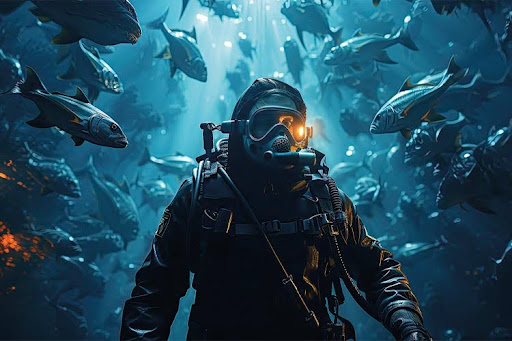Understanding Nitrogen Narcosis Symptoms

Nitrogen narcosis, often referred to as “the rapture of the deep,” is a condition that divers may experience when they descend to significant depths underwater. The condition is caused by an increase in the partial pressure of nitrogen, which is dissolved in the bloodstream due to the higher pressures encountered while diving. It is important for divers to understand nitrogen narcosis symptoms so they can take the necessary precautions to avoid it and react appropriately if they experience it.
What Is Nitrogen Narcosis?
Before delving into the symptoms, it is crucial to understand what nitrogen narcosis is and how it occurs. When divers go deeper into the ocean, the pressure around them increases. As a result, gases that are present in the air we breathe, such as nitrogen, dissolve into the bloodstream at higher rates. At greater depths, the nitrogen becomes more concentrated and may affect the brain in a way that produces narcotic-like effects, which can impair a diver’s ability to think clearly, move efficiently, or make sound decisions.
Symptoms of Nitrogen Narcosis
The severity of nitrogen narcosis symptoms varies depending on the depth of the dive and the individual’s susceptibility. Some divers may experience mild effects, while others could be significantly impaired. The following are the most common nitrogen narcosis symptoms:
- Euphoria and Overconfidence
One of the most common nitrogen narcosis symptoms is a feeling of euphoria or extreme well-being. This can lead to a sense of overconfidence and reduced caution. Divers may feel a false sense of security and may be more likely to take unnecessary risks. This is particularly dangerous because it can cause them to overlook safety protocols or underestimate the hazards of deep-water diving. - Impaired Judgment and Coordination
Nitrogen narcosis often impairs judgment and coordination. Divers may have difficulty concentrating, making decisions, or following simple tasks. For instance, they might struggle with remembering their dive plan, handling their equipment, or following the proper ascent procedure. Poor coordination can also cause a diver to move sluggishly or make erratic movements, which increases the risk of accidents. - Dizziness and Nausea
Dizziness and nausea are common nitrogen narcosis symptoms, especially in deeper dives. The disorienting feeling of dizziness can make it harder for a diver to navigate underwater or to communicate effectively with other divers. Nausea may result from a combination of factors, including the physical effects of nitrogen on the brain and the stress of being in a high-pressure environment. - Visual and Auditory Disturbances
Divers may also experience visual and auditory disturbances when affected by nitrogen narcosis. These symptoms can include blurred vision, tunnel vision, or distorted sounds. Such disturbances can make it difficult for divers to clearly see their surroundings, spot potential hazards, or communicate with fellow divers. This can be especially dangerous when exploring complex or deep dive sites where situational awareness is critical. - Difficulty with Fine Motor Skills
Nitrogen narcosis can interfere with a diver’s ability to perform precise movements. Fine motor skills are often affected, making it hard to operate dive equipment such as regulators, buoyancy control devices, or underwater cameras. This can lead to problems with maintaining proper buoyancy or controlling ascent and descent rates, which are essential for a safe dive. - Memory Loss or Forgetfulness
Another symptom of nitrogen narcosis is short-term memory loss. A diver may forget important details of their dive, such as their depth, the time spent underwater, or their planned ascent procedure. This can be extremely hazardous because it may lead to failure to follow critical safety protocols like monitoring air supply, diving within safe depth limits, or conducting a proper decompression stop during ascent. - Anxiety and Paranoia
While some divers may feel overly relaxed or euphoric, others may experience anxiety or paranoia. This can manifest as a feeling of dread or unease, and the diver might believe they are in immediate danger, even when there is no actual threat. Anxiety can impair rational thinking, which may lead to irrational behavior, such as trying to ascend too quickly or abandoning dive plans. The psychological effects of nitrogen narcosis are just as important to understand as the physical symptoms. - Respiratory Issues
Although not as common, some divers may also experience respiratory issues as a result of nitrogen narcosis. The condition can lead to irregular breathing patterns or a sensation of shortness of breath, which could be mistaken for other diving-related issues such as hypoxia. Divers should always remain aware of their breathing and take corrective action if they notice any irregularities.
FOR MORE INFORMATION CLICK HERE : dubai safari zoo tickets
How to Recognize Nitrogen Narcosis Symptoms
It is important for divers to recognize nitrogen narcosis symptoms early so that they can take appropriate action. Recognizing the symptoms can be difficult, especially for the diver experiencing them, but diving partners can often observe changes in behavior. If a diver exhibits signs of impaired judgment, confusion, or euphoria, it may be a sign that they are suffering from nitrogen narcosis.
Divers should always be mindful of the depth they are reaching and how long they have been underwater. If they start to experience any of the symptoms mentioned above, it is crucial to ascend slowly to shallower depths, where the effects of nitrogen narcosis will decrease.
Preventing Nitrogen Narcosis
The best way to manage nitrogen narcosis is through prevention. Some basic strategies include:
- Limiting Depth: Staying within recreational diving limits (typically no deeper than 40 meters or 130 feet) can reduce the risk of experiencing nitrogen narcosis.
- Taking Frequent Breaks: Making periodic stops during a dive can help give the body time to eliminate excess nitrogen from the system.
- Using Mixes with Less Nitrogen: Some advanced divers may choose to use specialized gas mixtures like trimix (a combination of oxygen, nitrogen, and helium) to reduce the amount of nitrogen inhaled at great depths.
Conclusion
Nitrogen narcosis symptoms can pose a serious threat to divers, but by understanding and recognizing these symptoms, divers can take measures to avoid accidents and dive safely. By staying within safe depth limits, monitoring physical and mental changes, and maintaining good communication with dive partners, divers can minimize the risks associated with this condition. Always remember that safety should be the top priority when exploring underwater environments, and being aware of nitrogen narcosis symptoms is an essential part of ensuring a safe and enjoyable dive experience.






